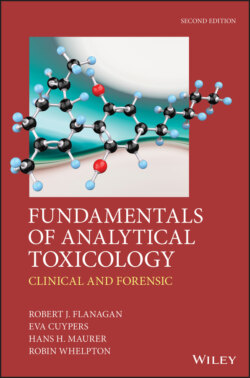Читать книгу Fundamentals of Analytical Toxicology - Robin Whelpton - Страница 33
1.4.5 Occupational and environmental toxicology
ОглавлениеThe monitoring of occupational or environmental exposure to toxic substances is an important area. Metal ions such as lead and also some organochlorine pesticides such as chlordane and dieldrin have long half-lives in the body and thus accumulation can occur with prolonged exposure to relatively low concentrations. The manufacture of drugs can also present a hazard to those involved via either dermal, or inhalational absorption. The misuse of alcohol and of controlled drugs is of concern in occupational medicine, especially as regards screening for substance misuse amongst potential employees and amongst, for example, operators of heavy machinery and pilots, as discussed above.
Control of occupational exposure to toxic metals, volatile solvents, and of some other substances is an integral part of industrial hygiene and has been achieved, in part, by monitoring ambient air concentrations of the compound(s) under investigation. However, an individual's work pattern and attention to safety procedures may greatly influence exposure and ‘biological effect’ monitoring, where clinical chemical parameters such as blood zinc protoporphyrin are measured as an indicator of lead exposure, is required practice in certain occupations.
Not all poisons are amenable to effect monitoring and so ‘biological’ monitoring is performed widely. This involves measuring blood, urinary, or breath concentrations of a compound, and possibly of its metabolites. The ACGIH (2018) recommends Threshold Limit Values (TLVs) for more than 700 chemical substances and physical agents. There are also more than 50 Biological Exposure Indices (BEIs) that cover more than 80 chemical substances. The DFG (2018) ‘MAK List’ (maximum allowable concentration in workplace air) classifies more than 1000 compounds according to their toxicological profile and gives threshold values for their use.
The investigation of the accidental release of chemicals into the workplace or into the environment (so-called chemical incidents) is an important area. Examples include the Bhopal disaster in India when methyl isocyanate was released into the atmosphere and the Camelford incident in the UK, in which aluminium sulfate was accidentally added to the local drinking water supply. Toxicological analyses can be valuable not only in providing evidence of the nature and magnitude of an exposure, but also in demonstrating that no significant exposure has occurred, thereby allaying public apprehension. Clearly, the early collection of appropriate biological samples is essential.
In the absence of information to the contrary it is wise to collect 10 mL whole blood (2 x 5 mL EDTA anticoagulant) and at least 25–50 mL urine (no preservative) from exposed or possibly exposed individuals. The time and date of sampling and the patient's full names should be recorded on the samples and also on a separate record sheet. The samples should be stored at either 4 °C or –20 °C until the appropriate analyses can be arranged. If the incident is investigated in retrospect then samples may exist in a local hospital laboratory, for example.
The increasing use of herbal or other ‘natural’ remedies is an area of especial concern. Whilst most, but by no means all, herbal preparations are innocuous (Belsey & Karch, 2015; Byeon et al., 2019), adulteration or contamination with dust, pollens, insects, rodents, parasites, microbes, fungi, mould, toxins, pesticides, toxic metals, and/or prescription drugs, is not uncommon (Byard, 2010; Posadzki et al., 2013; Steyn et al., 2018). This adds to the difficulty of diagnosing poisoning with these agents, each of which many contain dozens if not hundreds of different compounds, all at relatively low concentrations.
One area that has been neglected somewhat is that of food-derived poisons. Botulinum toxin and other toxins of microbiological origin are usually considered together with food poisoning. Poisoning from other naturally occurring substances, which include atropine from Atropa belladonna, solanine from potatoes, and cyanide from Cassava and from apple pips, also occurs, sometimes with homicidal intent (Bonnici et al., 2010). Here analysis of the foodstuff rather than biological samples can be more helpful in establishing the diagnosis in individual patients. Acute pesticide poisoning sometimes occurs after ingestion of contaminated produce and again analysis of the foodstuff can be helpful (Nasreddine & Parent-Massin, 2002).
